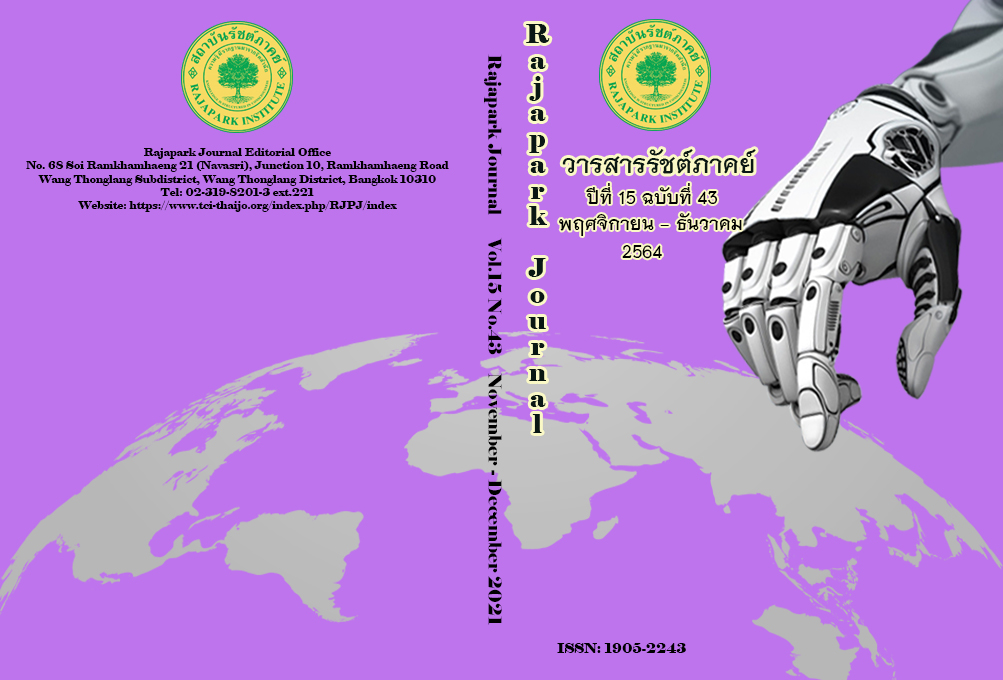Causal Relationship of Consumer Behavioral Intention to Use Food-Ordering Applications in the COVID-19 Pandemic Situation in Thai Social
Main Article Content
Abstract
The purpose of this research was to study the causal relationship of consumer behavioral intentions to use food-ordering applications in the COVID-19 pandemic situation. The participants were 200 people who were accustomed to the food ordering application. Conduct with a qualitative technique. The research instrument was a questionnaire by purposive sampling. And using the Structural Equation Model with Partial Least Squares technique for testing hypotheses. The findings revealed that attitude to use was the most influential factor that affected behavioral intention to use mobile food-ordering applications, followed by the desire to use, motivated consumer innovativeness socially, cognitively, hedonically, and functionally, respectively. The motivated consumer innovativeness functionally, hedonically, cognitively, and socially as an antecedent to having a positive direct effect on the desire to use, through attitude to use, to behavioral intention to use food-ordering applications. The findings of this research highlight the significance of comprehending the effects and causal model of motivated consumer innovativeness on behavioral intention to use food-ordering applications.
Article Details
Views and opinions appearing in the Journal it is the responsibility of the author of the article, and does not constitute the view and responsibility of the editorial team.
References
Chauhan, V., Yadav, R., & Choudhary, v. (2019). Analyzing the Impact of Consumer Innovativeness and Perceived Risk in Internet Banking Adoption: A Study of Indian Consumers. International Journal of Bank Marketing, 37(1), 323-339.
Chin, W. W. (2010). How to Write Up and Report Pls Analyses, In Esposito Vinzi, V., Chin, W. W., Henseler, J. And Wang, H. (Eds), Handbook of Partial Least Squares: Concepts, Methods and Applications, Vol. 2, Springer Handbooks of Computational Statistics Series. Springer, Heidelberg, 655-690.
Chiu, W., Kim, T., & Won, D. (2018). Predicting Consumers’ Intention to Purchase Sporting Goods Online: An Application of the Model of Goal-Directed Behavior. Asia Pacific Journal of Marketing and Logistics, 30(2), 333-351.
Davis, F. D. (1989). Perceived Usefulness, Perceived Ease of Use, and User Acceptance of Information Technology. Mis Quarterly, 319–340.
Dharmesti, M., Dharmesti, T. R. S., Kuhne, S., & Thaichon, P. (2019). Understanding Online Shopping Behaviours and Purchase Intentions Amongst Millennials. Young Consumers, 1-26. Doi 10.1108/Yc-12-2018-0922
Diamantopoulos, A., & Siguaw, J. A. (2006). Formative vs Reflective Indicators in Measure Development: Does the Choice of Indicators Matter?. British Journal of Management, 13(4), 263-282.
Electronic Transactions Development Agency [ETDA]. (2020a). Thailand Internet User Behavior 2020. Retrieved May 11, 2020, from https://www.etda.or.th/th/Useful-Resource/publications/Thailand-Internet-User-Behavior-2020_Slides.aspx
Electronic Transactions Development Agency [ETDA]. (2020b). ETDA Reveals That Gen-Y People Order Food Online the Most, and over 40% Order Because of the Dreaded of COVID-19. Retrieved May 11, 2020, from https://www.etda.or.th/content/online-food-delivery-survey-during-the-prevention-of-covid-19.html
Fornell, C., & Larcker, D. F. (1981). Evaluating Structural Equation Models with Unobservable Variables and Measurement Error. Journal of Marketing Research, 18(1), 39-50.
Hair, J. F., Hult, G. T. M., Ringle, C. M., & Sarstedt, M. (2014). A Primer on Partial Least Squares Structural Equation Modeling (PLS-SEM). California, CA: Sage Publications.
Han, H., & Yoon, H. J. (2015). Hotel Customers’ Environmentally Responsible Behavioral Intention: Impact of Key Constructs on Decision in Green Consumerism. International Journal of Hospitality Management, 45, 22–33.
Han, H., Lee, M. J., & Kim, W. (2018). Antecedents of Green Loyalty in the Cruise Industry: Sustainable Development and Environmental Management. Business Strategy and the Environment, 27(3), 323–335.
Henseler, J., & Sarstedt, M. (2013). Goodness-of-Fit Indices for Partial Least Squares Path Modeling. Computational Statistics, 28(2), 565-580.
Hwang, J., Kim, H., & Kim, W. (2019). Investigating Motivated Consumer Innovativeness in the Context of Drone Food Delivery Services. Journal of Hospitality and Tourism Management, 38, 102-110.
Kasikorn Research Center. (2019). Want to Eat, Must Eat, SMEs Restaurants Adjust for Food Delivery. Retrieved May 11, 2020, from https://kasikornresearch.com/SiteCollectionDocuments/analysis/k-social-media/sme/food% 20Delivery/FoodDelivery.pdf
Kaur, A., & Thakur, P. (2019). Determinants of Tier 2 Indian Consumer’s Online Shopping Attitude: A SEM Approach. Asia Pacific Journal of Marketing and Logistics. DOI 10.1108/APJML-11-2018-0494
Khoi, N. H., Tuu, H. H., & Olsen, S. O. (2018). The Role of Perceived Values in Explaining Vietnamese Consumers’ Attitude and Intention to Adopt Mobile Commerce. Asia Pacific Journal of Marketing and Logistics, 30(4), 1112-1134.
Raman, P. (2019). Understanding Female Consumers’ Intention to Shop Online: The Role of Trust, Convenience and Customer Service. Asia Pacific Journal of Marketing and Logistics, 31(4), 1138-1160.
Reinhardt, R., & Gurtner, S. (2015). Differences Between Early Adopters of Disruptive and Sustaining Innovations. Journal of Business Research, 68(1), 137–145.
Rovinelli, R. J., & Hambleton, R. K. (1977). On the Use of Content Specialists in the Assessment of Criterion-Referenced Test Item Validity. Dutch Journal of Educational Research, 2, 49-60.
Royal Thai Government. (2020). Current News on COVID-19. Retrieved May 3, 2020, from https://www.thaigov.go.th/news/contents/details/27963
Vandecasteele, B., & Geuens, M. (2010). Motivated Consumer Innovativeness: Concept, Measurement, and Validation. International Journal of Research in Marketing, 27(4), 308–318.
Venkatesh, V. (2000). Determinants of Perceived Ease of Use: Integrating Control, Intrinsic Motivation, and Emotion into the Technology Acceptance Model. Information Systems Research, 11(4), 342–365.
Wong, K. K. K. (2013). Partial Least Squares Structural Equation Modeling (Pls-SEM) Techniques Using SmartPLS. Marketing Bulletin, 24(1), 1-32.
Yang, K. C., Huang, C. H., Yang, C., & Yang, S. Y. (2017). Consumer Attitudes Toward Online Video Advertisement: YouTube as a Platform. Kybernetes, 46(5), 840-853.


